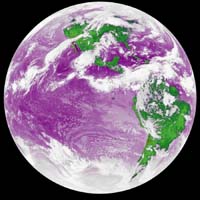| . |  |
. |
 Asteroid Devastation Leads to Ultraviolet Spring
Asteroid Devastation Leads to Ultraviolet Springby David Stauth Corvallis - March 13, 2000 - Researchers say in a new report that if a huge asteroid were to hit the Earth, the catastrophic destruction it causes, and even the "impact winter" that follows, might only be a prelude to a different, but very deadly phase that starts later on. They're calling it, "ultraviolet spring." In an analysis of the secondary ecological repercussions of a major asteroid impact, scientists from Oregon State University and the British Antarctic Survey have outlined some of the residual effects of ozone depletion, acid rain and increased levels of harmful ultraviolet radiation. The results were just published in the journal Ecology Letters. The findings are frightening. As a number of popular movies have illustrated in recent years, a big asteroid or comet impact would in fact produce enormous devastation, huge tidal waves, and a global dust cloud that would block the sun and choke the planet in icy, winter-like conditions for months. Many experts believe such conditions existed on Earth following an impact around the Cretaceous-Tertiary, or K-T boundary, when there was a massive extinction of many animals, including the dinosaurs. That's pretty bad. But according to Andrew Blaustein, a professor of zoology at Oregon State University, there's more to the story. "Scientists have pretty well documented the immediate destruction of an asteroid impact and even the impact winter which its dust cloud would create," Blaustein said. "But our study suggests that's just the beginning of the ecological disaster, not the end of it." Blaustein and colleague Charles Cockell examined an asteroid impact of a magnitude similar to the one that occurred around the K-T boundary, which is believed to have hit off the Yucatan Peninsula with a force of almost one trillion megatons. The immediate results would be catastrophic destruction and an impact winter, with widespread death of plants and the large terrestrial animals -- including humans -- that most directly depend on those plants for food. That's the beginning of an ugly scenario, the researchers say. As a result of the impact, the atmosphere would become loaded with nitric oxide, causing massive amounts of acid rain. As they become acidified, the lakes and rivers would have reduced amounts of dissolved organic carbons, which would allow much greater penetration of ultraviolet light. At first, of course, the ultraviolet rays would be blocked by the dust cloud, which sets the stage for a greater disaster later on. Many animals depend on some exposure to ultraviolet light to keep operational their biological protective mechanisms against it -- without any such light, those protective mechanisms would be eroded or lost. During the extended winter, animals across the biological spectrum would become weaker, starved and more vulnerable. Many would die. Then comes ultraviolet spring, shining down on surviving plants and animals that have lost their resistance to ultraviolet radiation and penetrating more deeply, with greater intensity, into shallow waters than it ever has before.
|
| |||||||||
| The content herein, unless otherwise known to be public domain, are Copyright 1995-2016 - Space Media Network. All websites are published in Australia and are solely subject to Australian law and governed by Fair Use principals for news reporting and research purposes. AFP, UPI and IANS news wire stories are copyright Agence France-Presse, United Press International and Indo-Asia News Service. ESA news reports are copyright European Space Agency. All NASA sourced material is public domain. Additional copyrights may apply in whole or part to other bona fide parties. Advertising does not imply endorsement, agreement or approval of any opinions, statements or information provided by Space Media Network on any Web page published or hosted by Space Media Network. Privacy Statement All images and articles appearing on Space Media Network have been edited or digitally altered in some way. Any requests to remove copyright material will be acted upon in a timely and appropriate manner. Any attempt to extort money from Space Media Network will be ignored and reported to Australian Law Enforcement Agencies as a potential case of financial fraud involving the use of a telephonic carriage device or postal service. |